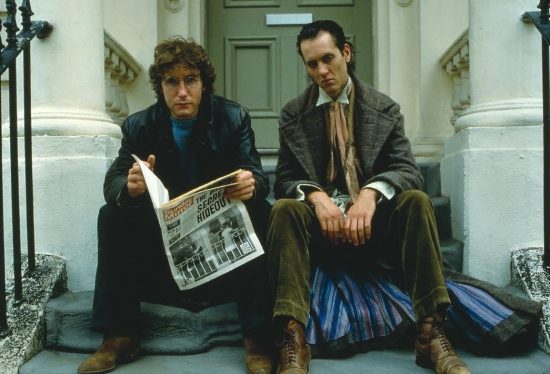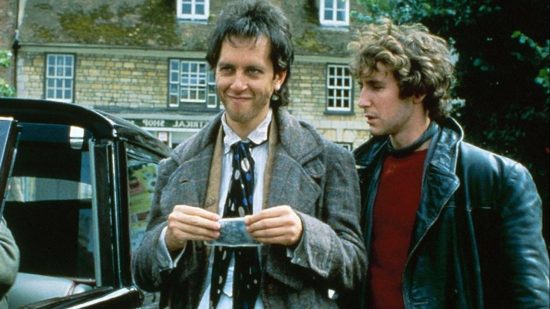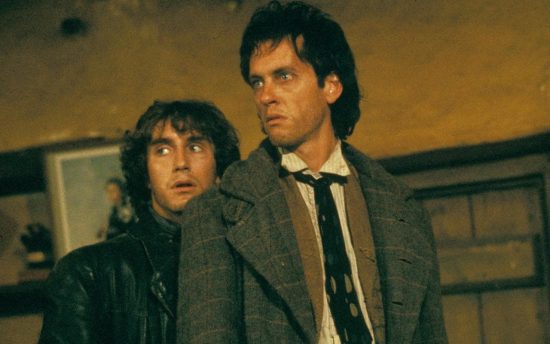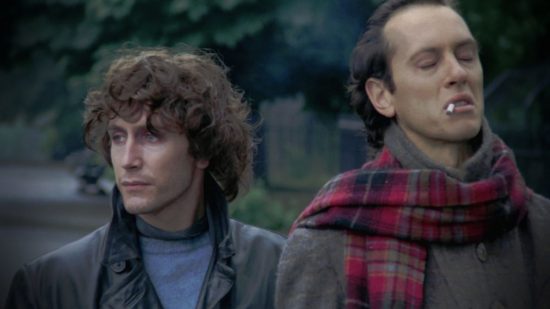View from The Aisle: Male Friendships in Withnail and I
Just before shooting began on Bruce Robinson’s 1987 film Withnail and I, Richard E. Grant received a frantic phone call from his wife Joan. She was going into labour two months prematurely. After tearing across London, Richard picked her up and sped off though traffic to the nearest hospital. Hours of anguished silence passed by. Richard paced the corridor. Eventually, a doctor approached and told him that their baby, a little girl, had died.
Only one week later, Richard was on set in the Lake District playing the debauched drunk Withnail, a garrulous, anarchic and jealous young actor totally at odds with Richard’s teetotal lifestyle; a character teetering on the edge of oblivion, trying desperately to avoid the realities of his situation. After a particularly vomit filled trial run at the behest of the film’s buyout director – including a vodka chugging session before rehearsal – Richard vowed to never partake in booze again. The grief was always there, in every quiet moment between takes, every lonely night away from Joan and yet, from this personal darkness, a few miraculous things occurred.
First, Grant gave the performance that would kickstart his career and catapult him into Hollywood stardom. Second, the production became renowned amongst the crew for being one of the most positive, enjoyable and fulfilling experiences of their professional lives and third, Bruce Robinson crafted one of the funniest stories ever put to film, a story that keeps on giving thirty-three years later like the crazed but hilarious jabbering of a lonesome drunk, stumbling ever onwards down an endless road.
It’s a deceptively simple tale: two out of work actors escape the hardships and drudgery of a London smoked out from the dying embers of the swinging sixties. What makes such a simple story endure to this day? For many, it’s the conversational banter between the two slovenly actors (Marwood and the titular Withnail) written with such confidence, such 3 am gin-addled bravado that the finished product remains on many a beer-soaked lip to this day.
Their drug-addled attempts to do the washing up, choosing instead to attack the sink with a fork; their encounter with a rowdy pub drinker who screams “ponce!” into Marwood’s bemused face; their run-in with – and subsequent paranoia of – a local game hunter, who hangs a rather illiterate note from the corpse of a dead rabbit nailed to their cottage door (reading: “here, hare, here”) and a drunken visit to a sleepy Lake District tea shop are all standout moments of comic stupidity. But as I’ve grown older and increasingly pedantic, another reading of this coffee-stained classic has emerged in my mind, one I hope that doesn’t betray the habits of my formal film education by looking for details where none exist. To be blunt: there are levels of emotional maturity to be uncovered in the interaction between Marwood and Withnail, which elevates the film above its farcical trappings to illustrate something pertinent about the nature of male friendships.
Here we go, another restless film snob trying to wax lyrical and drain the fun from any film they pass by like some crazed dementor. All I ask is that you hear me out before completely forgetting everything I’ve said.
We join both characters at a time of decrepit poverty, the kind which forces Withnail to cover his body with a layer of Deep Heat and keep his half-finished meals of fish and chips inside an unwashed toilet bowl. They are out of work, out of energy, growing increasingly bitter about the apparent success of everyone around them and yet, with the state of their lives seemingly in disrepair, one never leaves the other’s side. This relationship is never conveyed melodramatically. Marwood never embraces Withnail as a broad smile overcomes his face; Withnail never walks down a country lane next to his beloved friend before craning an arm over his shoulder, strolling off as one towards the waning sun. This is a friendship of unspoken trust built upon stability. While this may seem formulaic, ask yourself how many films portray male relationships in this way? Of course, there are some but as a self-proclaimed male this is quite an example.
There are two reasons why the representation of this friendship strikes so true. First, the film is autobiographical in nature. Withnail’s character is based on Bruce Robinson’s friend during the early, fruitless days of their acting careers named Vivian MacKerrell. In the documentary “Withnail and Us” Robinson describes Mackerrell as a “Jack of all trades but master of none” but still refers to him with affection. It’s a testament to the quality of Withnail that this warmth emanates through the screen, especially when you consider that Marwood – the curly-haired straight man played by Paul McGann – was actually based on Robinson himself. This central source of truth permeates everything else. Their dynamic is engaging and believable, their interplay natural. Nobody has to say how they feel. Be it the script, the performances, or even the damn set design (full of “well-lived” rooms littered with empty wine bottles and stained countertops) we already know it. These are two aimless souls with their heads just above the waterline, clinging to each other. Robinson echoes the traditional nature of male friendships, all shuffling feet and embarrassed mumbling whenever – god forbid – emotion is brought into play. It shouldn’t take a film scholar to note that shepherding this central element through the mad and often infuriatingly inefficient apparatus of film production is something to raise a glass at.
The second reason the relationship between Marwood and Withnail rings true is because of Richard E. Grant’s performance. In reality, Vivian Mackerrell died of throat cancer at the age of fifty. He was still alive when the film was released but it’s towards this inevitable outcome that the film narrative begins to curve. Grant perfectly captures this balance between debauchery (the moment he drinks a container full of lighter fluid) and depression (waking up hungover in the middle of a rainstorm “feeling like a pig shat” in his head). Withnail is a man running across a tightrope and – much like Grant at the time – struggling desperately to avoid the inevitable reality awaiting him at the end of the film when Marwood finally leaves. This final scene is the first and only time Withnail expresses genuine sadness and it’s because his friend, the one point of meaning in his life, has left. He stands alone, drinking in the rain and orating to the only audience willing to listen: a gaggle of stray dogs. Of course, there are innumerable narratives with tearful goodbyes but here Grant’s sadness – much like Robinson’s homage to Mackerell – rings true. As in many relationships, the unspoken nature of friendship stays silent until it’s too late. This is captured perfectly.
When balanced with the tragic elements of Withnail’s character, the comedic elements only serve to drive the film further away from comedy. The fall seems that much steeper after laughing your way to the edge. Richard E Grant’s performance fizzes with life and energy but also with sadness. He was a man curdling on the inside after the loss of his child, playing a character who gradually loses grip on the one person of meaning in his life. Few films have portrayed this form of unspoken brotherhood quite so truthfully and it’s when I allow myself to view the film through this lens, not simply as a panoply of one-liners and sixties excess but as a card trick played on the audience – lulling them in through humour, only to be left alone with Withnail standing in the rain – I see the film as deeply personal, filled with unspoken emotion and melancholy. There’s a quaint beauty in this and the reason I believe the film is still beloved today.
You can check out my company site or follow me on Twitter.













